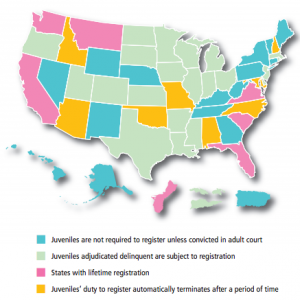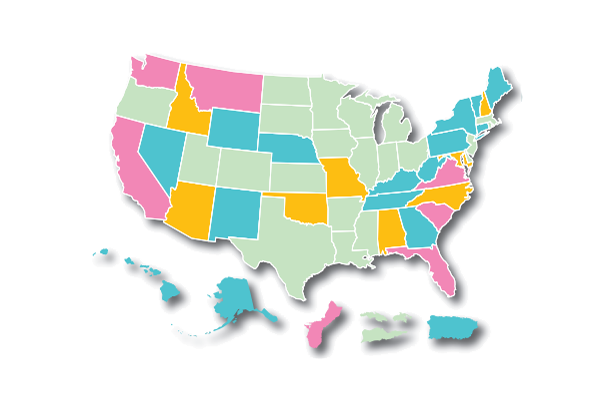
Juvenile sex offender registration varies widely by state, despite federal legislation aimed at standardizing requirements.
Juvenile sex offenders in Ohio will no longer be required to register as sex offenders for life, the state’s Supreme Court ruled last week. The 5-2 decision ruled the lifetime requirement is cruel and unusual punishment, reigniting a national debate on how young people convicted of certain sexual offenses should fare under the criminal justice system.
The majority opinion found certain parts of the Ohio Adam Walsh Act enacted in 2008 unconstitutional. Many states expanded laws pertaining to juvenile sex offenders following federal legislation in 2006 that sought to standardize how young sex offenders were classified and registered across the nation.
“Registration and notification requirements frustrate two of the fundamental elements of juvenile rehabilitation: confidentiality and the avoidance of stigma,” Ohio Justice Paul Pfiefer wrote in the court’s majority opinion. “Confidentiality promotes rehabilitation by allowing the juvenile to move into adulthood without the baggage of youthful mistakes.”
As a population, juveniles convicted of sexual offenses reoffend at a lower rate than their adult counterparts and juveniles charged with other delinquent behavior, according to the National Center on Sexual Behavior of Youth. About 5 percent to 14 percent of juvenile sex offenders reoffend recidivate by committing some form of criminal offense, compared to 40 percent of convicted adults and anywhere from 8 percent to 58 percent of juveniles who participate in other delinquent behavior.
Ohio was among the first to comply with near identical state-level laws, Pfiefer noted, yet since then many states have refused to follow suit – based largely on opposition to lifetime registration and notification requirements.
In 2011, the U.S. Attorney General Eric Holder modified guidelines to the federal law, Title I of the Adam Walsh Act, also known as the Sex Offender Registration and Notification Act (SORNA), removing the requirement that lower jurisdictions publicly disclose juvenile sex offender information following adjudication and making it optional for states to provide the same information to sex offender websites, schools and other specified groups.
That same year, the first comprehensive survey looking at state laws for juvenile sex offender registration was published. Among the findings in “A Snapshot of Juvenile Sex Offender Registration and Notification Laws: A Survey of the United States:”
- Juveniles are subject to sex offender registration and notification requirements in 35 states.
- Seventeen of the states requiring registration of juveniles adjudicated delinquent do not subject them to adult registration requirements.
- Juveniles are subject to lifetime registration in seven states.
“It feels like almost every state objects to the cost and the juvenile [privacy] issues,” Human Rights Watch Researcher and author of the snapshot, Nicole Pittman, said – adding that only three states (New York, California and Texas) have officially refused to comply. “Law enforcement does not feel it’s necessary to track kids like they do adult predators, and it’s taking away valuable resources.”
“It’s not an effective tool.”
Despite efforts to regulate the classification and handling of juvenile sex offenders across the nation, the study found that state registration requirements varied widely more than five years after the federal legislation went into effect.
The range of state laws is due, in part, to varying interpretations of SORNA, Pittman said.

And why should we believe ANY statistic given by ANY reason referring to this article:
http://www.futurity.org/society-culture/registry-may-overstate-sex-offender-counts/
Across the five states in the study, she found that only 43 percent, or 114,690 out of 201,135 sex offenders listed, were actually living in the communities designated by the registries.
By state, Ackerman found:
Florida had the greatest discrepancy, reporting 56,784 sex offenders when only 22,877—a 60 percent difference—were living in Florida communities.
New York, at 52 percent, had the second-highest discrepancy, listing 32,930 offenders in the registry with just 15,950 living in the community.(because they put the a name up 2, 3 4 times for the same person)
Illinois had a 48 percent difference, with 25,088 registered offenders and 13,066 actually residing in the community.
Georgia had a 36 percent difference, 20,212 listed on the registry and 7,201 living in the community.
At 25 percent, Texas had the lowest discrepancy, with 49,786 actual residents from the 66,121 sex offenders listed.
I’ve read that study, and right now the BJS web site is having issues. But I do have the same study on our Facebook page here:
https://www.facebook.com/note.php?note_id=238648859526824
And on our SkyDrive here:
https://skydrive.live.com/?cid=a754c96e86e37f71&id=A754C96E86E37F71!125#cid=A754C96E86E37F71&id=A754C96E86E37F71!510
The way people word things is what confuses people, and what I like to be clear. Any conviction is not the same a sex offense recidivism, which was what I was thinking about on my original comment.
It’s word jargon like that I don’t like.
For those who are arrested for a sex crime and later commit another sex crime, the recidivism rate is very low, not high like the general media continues to portray, and what the general public believes also.
I don’t like word smithing, and I’m not accusing you of such, because I know the original story came from elsewhere, since I also posted it on our blog.
Anyway, sex offender recidivism, for a new sex crime, is lower than 10% is almost all studies, and the 40% above is for any crime.
When an offender is forced to live like a leper, most are rearrested for technical violations or just being fed up with the draconian, unconstitutional laws, and many across this country are living under bridges homeless, and that potentially makes some more dangerous, when they lose all hope.
Anyway, thanks for the clarification.
Richard, great point. I’ve updated the article to (hopefully) clarify once and for all. I am, indeed, speaking of general recidivism here.
Actually, Clay, it’s not good enough. “Recidivate” still implies the commission of another sex crime. There’s a difference between specific recidivism (the commission of another sex crime) and general recidivism (the commission of another crime of any kind that isn’t a specific recidivism crime).
Specific recidivism rates for sex offenders is extremely low, between 3.5% and 10%, as Sex Offender Issues has said. However, because of the incredible restrictions and requirements placed on sex offenders, which are extremely easy to violate (and which will result in a new felony charge), general recidivism is artificially high.
Unfortunately, I have yet to see a study that separates out the “false positives” of violating the sex offender restrictions and requirements, and only includes actual new crimes. Such a study would give a truer picture of general recidivism among sex offenders.
Clay…You are the MAN!… Thanks. That was very decent of you.. I appreciate it.
Maddy, I fail to see how the numbers are inflated. Click the link to the study and see for yourself. I do, however, understand where you’re coming from. For someone unfamiliar with the definition, “reoffend” could be interpreted as an offender committing the same crime more than once, when it refers to the commitment of any crime after the first offense. I have, thus, changed it to “recidivate.” Hope it helps.
Clay… “a little unclear?” Is that something like a “little pregnant?” The comment and caveat in the “comments” needs to be CLEARLY and accurately woven into the STORY as such. Please reconsider what it says and EDIT it accordingly. Adult sexual recidivism at the very most, within a 3-year period of release is less than 8% PERIOD. It is well past time that the media, and especially “law enforcement”, STOP skewing (INFLATING) these numbers to serve their selfish agendas.
Sex Offender Issues,
The statistics come from a study done by the Bureau of Justice:
http://bjs.ojp.usdoj.gov/index.cfm?ty=pbdetail&iid=1136
http://bjs.ojp.usdoj.gov/content/pub/press/rsorp94pr.cfm
Thanks for the comment. I can see how it could be a little unclear. The statistics are for convicted adult sex offenders that reoffend for any crime, not just sexual related offenses.
The same study tracks adult inmates rearrested for sexual offenses within three years of their release, of which 5.3 percent reoffended.
The article states:
“About 5 percent to 14 percent of juvenile sex offenders reoffend, compared to 40 percent of convicted adults and anywhere from 8 percent to 58 percent of juveniles who participate in other delinquent behavior.”
Where did they get this 40% from? The many studies we have linked on our blog, show otherwise. They show the adult recidivism is low as well, around 3.5% to around 10%, give or take.
http://sexoffenderissues.blogspot.com/p/recidivism-studies.html